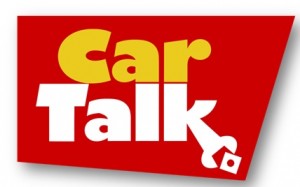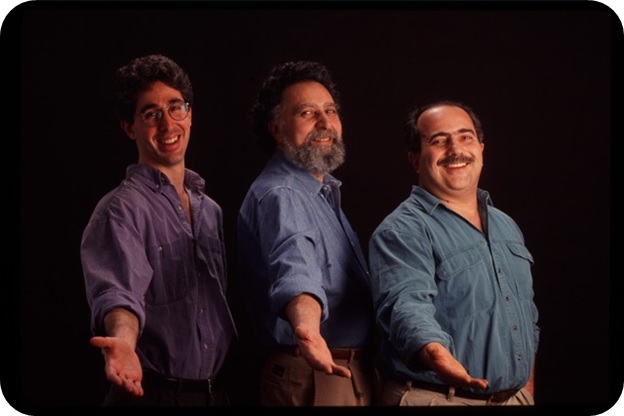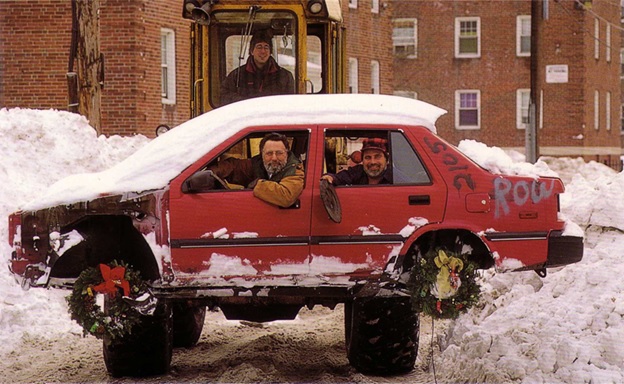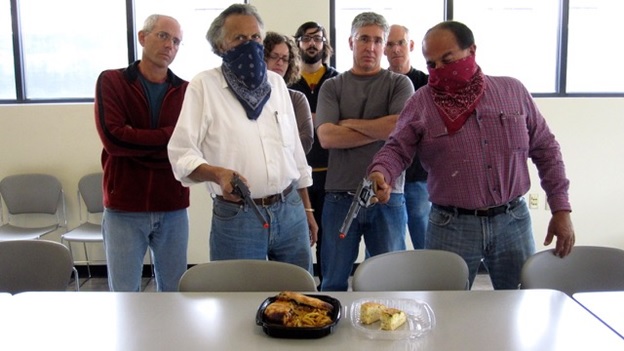One of the beauties of true innovations is that when they work, we accept them as the phenomenal winners they turned out to be. When they strike gold, it seems like they’ve always been there. But the truth is that in their beta stages many of these wild-eyed ideas weren’t exactly sure things, and vocal supporters were few and far between. That’s been a similar story for many of the innovations we’ve featured as a part of our “Radio’s Most Innovative” series.
 And that’s the case with NPR’s Car Talk – clearly one of the most amazing shows in the history of public radio that was also one of the most unlikely to succeed: two obviously Bostonian brothers talking cars, yukking it up, and making fun of each other every weekend on public radio stations across the country? On NPR. Go figure.
And that’s the case with NPR’s Car Talk – clearly one of the most amazing shows in the history of public radio that was also one of the most unlikely to succeed: two obviously Bostonian brothers talking cars, yukking it up, and making fun of each other every weekend on public radio stations across the country? On NPR. Go figure.
It was brought to market by Doug Berman, a guy who spent time in the public radio system, first at WFCR (Amherst, MA), and then WBUR/Boston, and even had a stint as president of the Public Radio News Directors Association back in the ‘80s. But as is often the case, vision, serendipity, happenstance, and just plain luck were co-stars in the creation of what became Car Talk.
 At WBUR, Doug met the Magliozzi brothers and success followed when the show went national. But if you think this incredible radio hit was one of those once-in-a-lifetime anomalies, Berman struck gold again about a decade later when he introduced another show that actually met and exceeded Car Talk‘s success – the weekly news quiz show, Wait Wait…Don’t Tell Me! – also on NPR. Doug is executive producer of them both.
At WBUR, Doug met the Magliozzi brothers and success followed when the show went national. But if you think this incredible radio hit was one of those once-in-a-lifetime anomalies, Berman struck gold again about a decade later when he introduced another show that actually met and exceeded Car Talk‘s success – the weekly news quiz show, Wait Wait…Don’t Tell Me! – also on NPR. Doug is executive producer of them both.
Along the way, he’s won two Peabody Awards, and was kind enough to take us out to the garage for the story behind Car Talk, this week’s “Radio’s Most Innovative” honoree. And in the process, Doug also provides us with a fabulous primer about what it takes to make great radio. You may want to take notes.
JM: So how did the idea for Car Talk originate?
DB: WBUR in Boston was a community station back in the 1970s. It had a show for every possible interest group. Name a completely non-viable broadcast audience, and WBUR had a show for them. People who repaired stereos? Got it. Gay former-prisoners? Check.
In that environment, the host of a talk show decided to do an episode on car repair. He invited six area mechanics, including Tom and Ray. Ray thought it was a dumb idea, so he suggested Tom go, and Tom was the only guy who showed up. He was a distinguished panel of one.
But it went well, and the host asked Tom to come back the following week. He said, “Sure, can I bring my brother?” During that intervening week, the host was fired, and Tom and Ray showed up to find a note telling them the time slot was theirs.
They didn’t know squat about radio. And that 10 year period, without a producer, without supervision, without any feedback, allowed them to become completely and utterly themselves in front of microphones, without any self-consciousness. No one told them they had to sound like broadcasters, or NPR hosts, so they never bothered. They became complete originals. It was a wonderful thing. Talent development through benign neglect.
I hooked up with them in early 1987, and we created a format and a production plan. I wanted to gear the show away from people who fixed their own cars, and more towards people who have to live in a world with cars—a much broader audience—and emphasize the humor over the technical information. So that’s where it went.

JM: When did NPR figure out it was a hit?
DB: Probably after about 75 stations picked it up. That was about the same time we figured out it was a hit, too. There are people at NPR who claim to have discovered the guys toiling away locally on WBUR: Susan Stamberg, Robert Seigel, Jay Kernis. I believe all of them, because I don’t want any of them mad at me. But it was WBUR’s General Manager at the time, Jane Christo, who put her money on it in 1987, and paid to produce our pilot and distribute the show.
JM: Why did you think public radio was the right place for the show?
DB: Well, honestly, we didn’t know any better. That’s where we were based, people were nice to us, and the show was doing well for the station. In many ways, it was an imperfect fit. The big programming battle in public radio during the ‘80s was news versus classical music. No one even thought about comedy. NPR occasionally did “clever.” But not funny.
On the other hand, there were things that made it a great match. There was really no commercial pressure at NPR. So, if Ray wanted to say, for instance, that the Ford Festiva was such a death trap that it should come from the factory with a funeral wreath on the grill, he could say that. In fact, he did say that. And the guys’ absolute honesty, which the audience totally understood, became one element of their appeal. So that made NPR a great fit.
There’s also a real warmth and intelligence to their humor, even though they act like class clowns. The guys have a very positive view of humanity that runs beneath all of their humor, and I think that matched well with NPR’s listeners.
Of course, both analyses were correct. The show became a core program for NPR listeners, who totally embraced the guys, and it also pulled in more P2s and non-NPR listeners than any other show on the network, and introduced a lot of Americans to public radio.
So it wasn’t a perfect fit, but it was a great fit. It changed NPR’s public image, broadened its audience and appeal, and helped it make the transition from the alternative fringe to a mainstream American broadcaster over a couple of decades.
I think it could have succeeded elsewhere. A number of commercial networks came to us later to try to sign us away from NPR. But by that point, we felt very loyal to NPR stations and their listeners. And we thought about it for about five minutes, and re-signed with NPR for a long time.
JM: If Car Talk was in beta mode today, the elevator pitch would be a tough sell. Why did the show work?
DB: Tom and Ray are extraordinary talents. And I think the real reason so many people listen is that it’s great to spend an hour with them every week. And that’s why it’s still one of NPR’s top rated shows, even now, in syndication. It’s fun, it’s enlightening, it’s life-affirming. I think we did a good job of building a format for them and editing them well, but the bottom line is great talent.
JM: Is it about the topic or is Car Talk a great example of personality and chemistry?
DB: I think the topic is really just an excuse for the guys to be on the air and talk to people. It’s a mechanism. It gives them a task, a challenge… a purpose that moves the action forward during the hour. And while pursuing that goal of answering car questions, all of the real show happens.
Trying to solve people’s car problems is the narrative that runs underneath the show, and gives the show its forward momentum. But a good number of our listeners don’t really care about cars. And the guys don’t really care that much about cars either. They’re more interested in the people.
Early on, a PD in a very major market—OK, the one with the Empire State Building—told me that he wasn’t going to add the show because people in New York didn’t drive, so no one would listen. Of course, that was ridiculous. I think his replacement added the show a few years later.
JM: How much coaching did the Magliozzi brothers require or was this a case of just letting them go?
DB: They never needed to be coached into having a good time. Before every show I’d go into the booth and remind them of the three things I wanted them to do: Answer the questions, get to know the contestants, and have fun. If they did all three of those, whatever else happened, I’d have everything I needed to make a great show.
We did a lot of preparation that they weren’t involved in. We did a ton of pre-screening to find a really good mix of callers that we thought the guys would respond to. We had some scripted elements that they had to hit. I had a talkback in their ears, to redirect them, suggest an occasional joke, get them to clarify stuff, or get back to answering the question so the call had an ending.
But the basic idea was to set it up as well as we could, get the conditions right, and then let them go. Then we’d record about 90 to 100 minutes, and edit the best of it down to a broadcast hour.
JM: What lessons from Car Talk can we take for other radio shows, whether public or commercial? Or can we?
DB: When I was developing Wait Wait…Don’t Tell Me! in the ‘90s, I asked myself the same question. And the areas I focused on were talent, production, and editing.
In terms of talent, authenticity is key. You want people who are the real thing. Tom and Ray were just as interesting and funny in the green room, or at lunch, as they were on the air. There was no faking anything. So there’s no energy wasted in creating an on-air persona. That makes it infinitely sustainable.
You can step up your game to a certain extent on the air. But if there’s not enough there…if your talent isn’t someone you would actually want to be around for an hour a week, or a couple of hours a day, people will eventually hear that.
In terms of production, we worked really hard to increase our chances of success in advance. We’d go through 1,000 wannabe callers a week and pick the best dozen or so. We found and prepared topical material that we knew the guys would have fun with. We kept the mood light and fun, and gave them very little to worry about. We wanted to put them into a situation where they could come into the studio once a week and actually have a great time with callers. Because we believed you could hear that.
And then, once we had our 90 or 100 minutes of that on tape, we spent a couple of days editing it and making it into a coherent sounding show, with good pacing and rhythm. We knew that not every call would be great, and not every digression in every call would be funny. But by the time we aired it, we wanted every damn minute of the show to sound great, and to sound like it just happened that way.
That’s an NPR thing I picked up when I worked on the news shows. Try not to waste a second of your listener’s time. Any moment that’s not actively interesting or funny, or setting up something that is, goes on the editing room floor. That’s how you earn listenership.
I know editing is a luxury we had as a once-a-week broadcast. But that was probably the real magic sauce, on the production side.
JM: How did the closing credits with the crazy nicknames begin? (You are, of course, Doug “the subway fugitive, not a slave to fashion, bongo boy frogman” Berman.)
DB: It started because Tom was discussing a news story on the show one week about how smokers are bad drivers. He quoted the author of the study, a Dr. Joseph DiFranza. And he went on to give his theory about why smokers are worse drivers…illustrated with a lot of guffaws and personal story about how he was once driving and dropped a hot ash down into his crotch. This became an audience favorite, and to get a laugh out of Tom, we started slipping Dr. DiFranza into the credits as our Automotive Medical Researcher.
We did it for a few weeks, but then I got concerned that we might be subject to some kind of liability for making fun of this poor guy, who was probably a serious scientist.
Well, lo and behold, just a few weeks after that, a large envelope arrives from a Dr. Joseph DiFranza. Uh oh, I thought. Here’s the lawsuit. So we open it up, and it is, in fact, is from the very same Dr. DiFranza who did the study. And he wanted to know why we had stopped mentioning his name in the credits!
After that, we just started adding stuff. The goal was to get the guys to laugh during a part of the show that tends to be pretty dull and rote, and therefore a way to keep people listening to the end of the hour. And then it just became part of the show. You know, the head of our working mother support group is Erasmus B. Dragon, and stuff like that.
JM: The show continues on despite the Magliozzi brothers retiring in 2012, and Tom’s passing late last year. How is it doing and how challenging is it to produce shows now?
DB: It’s doing really well. The numbers have stayed right in line with all of NPR’s programming.
We didn’t want to just air “reruns” of old shows. We wanted to try to produce an ongoing, weekly series from the 25 years of material we’d produced. So we’ve got every call rated in a database from 1 to 5, with 5 being the best. And we figured out that if we created new shows going forward just using the 4s and 5s, we’d have eight years of material. It’s like a second editing pass at a 25-year long series, resulting in an 8-year “Best Of.”
There are challenges. In building those calls into shows, we have to be really attentive to continuity, with weekly puzzlers that get answered the following week, and appropriate references to “last week” and “next week” and “someone who called a few weeks ago.” We make sure it all hangs together.
The biggest challenge is to avoid distracting people from their enjoyment by having something come up that’s totally anachronistic. So, if a caller says, “I’ve got a 2002 Honda Civic, and it’s still under warranty,” we’ll take that out. It’s the kind of thing that might cause someone to stop enjoying the moment, and have to think “what?” And we don’t want that.
We’ve also got an amazing producer named David Greene, who goes to great lengths to make each week’s show sound like it could be live this week. The most unbelievable thing he did was about a year ago, when the cicadas were news again. They pop out of the ground, like, every 17 years or something. Sure enough, he found the guys joking with a caller about “the cicadas,” from 17 years earlier.
It’s not like we’re trying to fool anybody into thinking the show is still live. We’re just trying to make it enjoyable, and eliminate anything that would distract them from the pleasure of listening. So that’s what we’re editing for.
JM: What advice do you have for anyone in radio with an innovative idea that is having trouble making it happen?
DB: Give up. No. It’s so hard to know what’s genuinely amazing and just hasn’t been done before vs. what hasn’t been done before because it’s a lousy idea.
I trust my own judgment. If I can’t stop listening to something, then I feel like there’s something there – regardless of the format, the style, the topic, or the network. If I find my mind wandering, if I catch myself not listening, then it doesn’t matter how much the idea makes sense or how well known the talent is. And I think a lot of producers and programmers just don’t apply their own deeply honest judgment that way. They know something’s not great, but they try to convince themselves that other people might go for it.
But the bottom line is that there’s no arguing with an audience. If you’re working on something, even if it’s a podcast, and more and more people are giving up their own valuable time to listen –when they could be streaming Better Call Saul — then it’s working. That’s the ultimate test. So you’ve got to offer it up somehow, and measure the results. And you have to accept those results. So get it out there and see what happens. And if it sucks, try again. Or try nursing school.
INNOVATION QUOTE OF THE WEEK
“If I had asked people what they wanted, they would have said faster horses.”
Henry Ford
More of Radio’s Most Innovative
- Radio’s Most Innovative: “Radio’s Best Friend” Art Vuolo
- Radio’s Most Innovative: Steven Price/Townsquare Media
- Radio's Most Innovative: Andy Economos' Selector
- Radio’s Most Innovative: Dr. Ruth Westheimer
- Radio’s Most Innovative: Austin City Limits Radio
- Media And Technology In 2025: Believe It Or Not! - April 18, 2025
- In Radio, You Just Never Know - April 17, 2025
- The Secret To Making A Great Podcast (And Great Radio) - April 16, 2025







Here’s the gem from this one: “Try not to waste a second of your listener’s time. Any moment that’s not actively interesting or funny, or setting up something that is, goes on the editing room floor. That’s how you earn listenership.” It’s too bad “fake live” like this can’t be made to work more often… then we wouldn’t have to listen to all these live morning shows and call-in show train wrecks. Of course, here’s one solution that didn’t work out so well… https://www.youtube.com/watch?v=dCSRnJCbmDo but is hilarious!
I knew Bob Odenkirk would show up eventually. Remember, Doug Berman said “Try.” Thanks for the comment, Paul, and for reading our blog.
The first time I heard Car Talk, I was driving with my girlfriend from Flagstaff, Az. to the Grand Canyon. This would have been spring of 1984. I was in a powder blue VW superbeetle, which had some significant mileage on it. Patti and I started giggling a few minutes into the broadcast but soon I was laughing so hard that I had to pull over to the side of the road. Patti, on the other hand, had taken out a pocket notebook and was taking notes.
Good thing. A few weeks later, the accelerator cable on that VW bug broke. I was all set to take it to the local VW repair shop – Patti said “No, no – I know what to do!” She’d written down a tip she’d heard on Car Talk – to replace the broken accelerator cable with bent piece of a coat hanger. Worked like a charm! I’ve been a huge fan ever since.
Eric, there are lots of “Car Stories” like yours – that great combo of humor and homespun knowledge. Thanks for sharing it.
Just a few minor corrections to Doug’s history of CarTalk. WBUR isn’t a community station now and it wasn’t in the 1960’s or 70’s. The license is owned by Boston University and so it is and always was a university licensee. Also, it did not have a radio program for every conceivable interest such as ” People who repaired stereos? Got it. Gay former-prisoners? Check.” In fact, WBUR in the late ’60’s and ’70’s programmed mostly classical, folk and jazz music with a variety of excellent public affairs programs. One of the latter was an innovative daily three-hour program that started at 6:00 p.m. called, The Drum. The Drum billed itself as “by and for the Black community.” It was created by Preston Webster, a charismatic broadcaster and community leader. Not surprisingly, the Black community in Boston -including listeners and various foundations- gave the program considerable financial support. And Doug isn’t quite right about the origins of CarTalk. What happened was that in 1968 a radio program about high fidelity was created on WBUR. With companies such as Bose, AcousticResearch and many others, Boston was a key center for the high fidelity industry. The show ran on Saturday morning, it had two pretty wacky hosts and it was a call-in program. Sound familiar? I created that program and was one of the original hosts. The name of the show was thought up by a WBUR opera producer by the name of John C. Calhoun. The name he came up with was ShopTalk. Sound familiar? I left the show as co-host just a few months after it started but it continued every Saturday morning for 10 consecutive years. And then WBUR’s program director at that time, Vic Wheatman, had an idea. How about a show just like ShopTalk but make it about cars. To find out about Vic and what happened next, I recommend going to the source: cartalk.com, where you’ll find an excellent history of the program. Finally, there’s one key individual who made WBUR what it was in those days, including making WBUR the first listener supported station in New England, green lighting ShopTalk, The Drum and many, many other innovative programs and formats. That’s Will I. Lewis. Among other positions he’s held, Will went on to spend many years working with Ruth Seymour to make KCRW the cutting-edge station it is. Will is one of the most creative and original people public radio has ever seen and so I’m afraid the blame for CarTalk has to be laid at his feet.
Steve, thanks for the perspective.
I’ve gotten a lot of professional mileage as the “creator” of Car-Talk. But of course the creators were Tom and Ray. I just “created” the opportunity and the fates let me to the brothers. Got lucky I guess.
Vic Wheatman
Correction: it wasn’t John C. Calhoun. It was Richard Calhoun.
As an ex-Michigander I was fascinated with Click & Clack when we moved to the Boston area in 1980. Shortly thereafter I was on CarTalk and got the correct answer to my car problem. I taped it but later inadvertently taped over it. I would donate almost any amount of money to a charity appropriate for Tom’s memory if Doug Berman or anyone could help me to get a copy of that 5 minutes. I can identify quite accurately the exact date. This was before the show went national. Can anyone help?